Current Projects
The following list of projects that are currently being worked on by KISMA. A description and list of accomplishments are provided for each project. These projects are funded by a range of partners. To find out more about KISMA's mission and our partners, visit the About KISMA webpage. Page last updated in September, 2024.
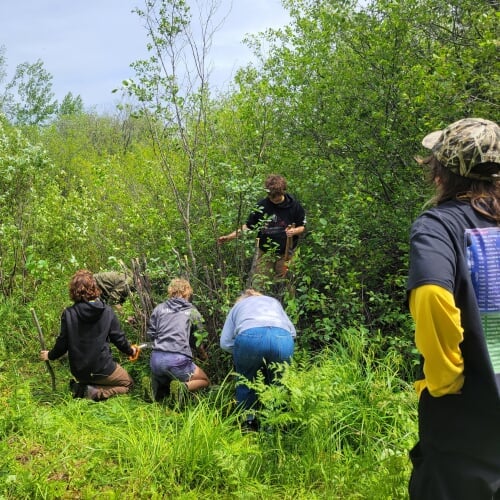
KISMA crew and volunteers removing invasive buckthorn from the side of a trail.
Photo credit: KISMA
Healthy Forests, Healthy Communities
Weekly volunteer events held with the Swedetown Trails Club
What We Do
Portions of the Swedetown Trails are heavily infested with invasive glossy buckthorn (Frangula alnus), preventing forest regeneration, degrading native habitat, and reducing the overall quality of this cherished local trail system. We are partnering with the Swedetown Trails Club, working to restore the health of this forest one step at a time, and we could really use your help!
The "Healthy Forests, Healthy Communities" events are regularly scheduled, family friendly and educational events open to anyone who's interested. We will be using a variety of buckthorn control methods including pulling by hand and with root wrenches, cutting, trimming, and hauling it all away at the end of the day to be burned. We hope you will join us!
Where and When
- Events held every Friday, June 6 to August 15
- 1 to 3:30pm
- At the Swedetown trail head and Chalet (56641 Osceola Road, Calumet)
- Events will be held in all weather conditions except for heavy rain and thunder. Be sure to check the KISMA and Swedetown Trail's social medias ahead of time for more updated information.
- (additional workdays continuing into the fall soon to be scheduled)
What to Bring
- Water and snacks to stay fueled
- Work gloves, eye protection, sturdy footwear and protective clothing recommended
- Tools and equipment will be provided
 KISMA crew washing a boat.
KISMA crew washing a boat.
Photo credit: KISMA
Aquatic Invasive Species Prevention
Funded by the National Park Service and USDA Forest Service
What we do
- Provide free mobile boat wash stations throughout Keweenaw, Houghton, and Baraga counties.
- Provide educational materials about aquatic invasive species to boaters and fishermen.
- Work to prevent the spread of aquatic invasive species.
Accomplishments to Date
- Nearly 1000 people contacted at local boat wash events.
- Boat washes hosted at 15 different boat launches.
- Over 150 boats washed since 2021.
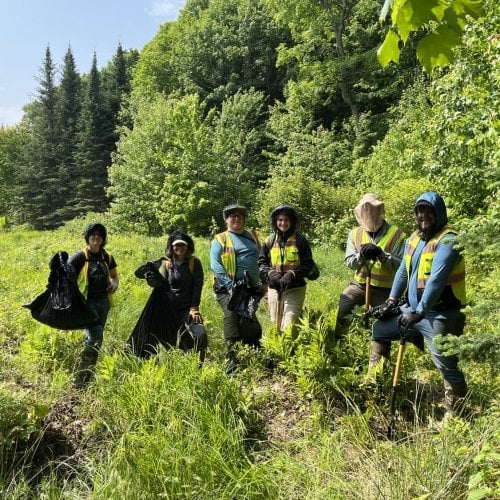 KISMA Terrestrial Crew holding bags of invasive thistles they had removed near Gratiot
Lake.
KISMA Terrestrial Crew holding bags of invasive thistles they had removed near Gratiot
Lake.
Photo credit: Emily Klawiter
Terrestrial Invasive Species Crew
Funded by USDA Forest Service, Great Lakes Restoration Initiative
What we do
- Assist private landowners and partners to create a plan and manage invasive species on their property.
- Terrestrial surveys for invasive species.
- Educate community members about invasive species
- Primarily use manual and biocontrol methods to remove and mitigate the impacts of priority invasive species.
Accomplishments to Date
- Over 72 acres treated for invasive species since 2022.
- Over 400 people contacted for invasive species education since 2022.
- Countless social media engagements and interactions.
- 5 volunteer events hosted since 2022.
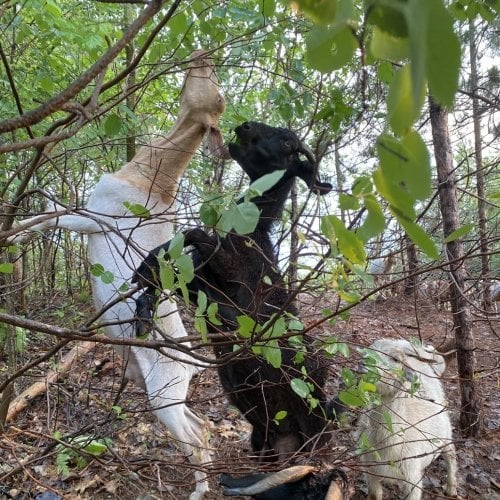 Goats eating buckthorn at Swedetown Trails.
Goats eating buckthorn at Swedetown Trails.
Photo credit: KISMA
Swedetown Trails Goat Project
Funded by USDA Forest Service, Great Lakes Restoration Initiative
What we do
- Bring goats to browse glossy buckthorn at the Swedetown Trails in Calumet, MI. Goats are owned and managed by Jake and Brigid Williams of Regenerative Ruminants from Wisconsin
- Examine the impacts of goat browsing and the invasive glossy buckthorn on various ecological factors (soil, vegetation, moths and insect herbivory, and bird usage).
- Reseed the grazed areas with native plants.
Accomplishments to Date
- Goats browsed nearly 5.5 acres in 2023.
- Collected pre-browsing data on vegetation composition, insect herbivory, bird use, moth presence, and forest and soil floor carbon and nitrogen to compare once browsing is complete.
- Reached over 175 people at Greet the Goats events in 2023.
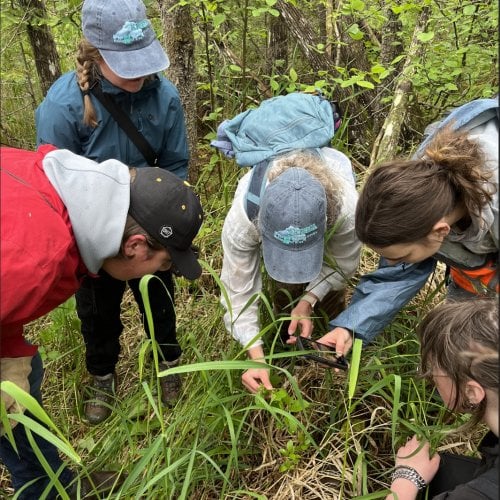
KISMA crew identify a plant on a survey.
Photo credit: Emily Klawiter
Landscape Prioritization
Funded by USDA Forest Service, Great Lakes Restoration Initiative
What we do
- Use GIS to map out high priority (high quality habitat with medium to high invasion risk) areas for invasive species survey and management.
- Survey and treat those high priority sites for terrestrial invasive plants.
Accomplishments to Date
- Created a map intersecting an invasion risk model with a quality habitat model classifying priority lands across the KISMA tri-county area.
- Surveyed over 1000 acres in 2024.
- Managed over 30 acres of invasive species in 2024.
Past Projects.
The following list of projects have been completed by KISMA from 2016 to the present. A description and list of accomplishments are provided for each project. These projects were funded by a range of partners. To find out more about KISMA's mission and our partners, visit the About KISMA webpage. This list was last updated in September, 2024.
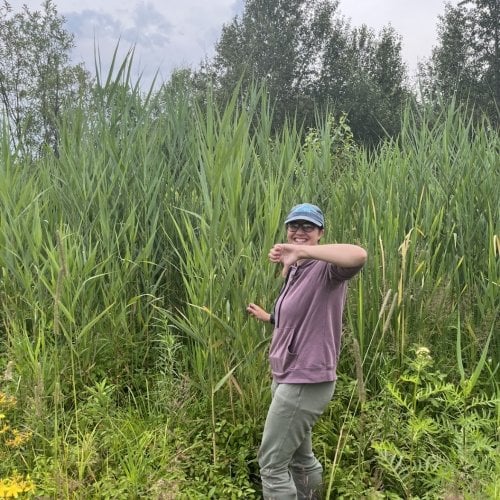 KISMA crew next to invasive Phragmites.
KISMA crew next to invasive Phragmites.
Photo credit: Emily Klawiter
Upper Peninsula Invasive Phragmites
Funded by Environmental Protection Agency, Great Lakes Restoration Initiative through the Michigan Department of Natural Resources
What we did
- Surveyed for invasive Phragmites throughout our management area.
- Managed known patches of invasive Phragmites in our management area.
- Educated community members about how invasive Phragmites spreads and impacts habitat.
Accomplishments to Date
- Nearly 800 linear miles of roads and shoreline surveyed.
- 2 acres of invasive Phragmites treated.
- 2 sites enrolled in the Phragmites Adaptive Management Framework.
- Over 30,000 people reached to spread the message about invasive Phragmites.
- No new patches of invasive Phragmites found from 2022-2024.
 KISMA crew after a manually manging knotweed.
KISMA crew after a manually manging knotweed.
Photo credit: Emily Klawiter
Knotweed Project
Funded in collaboration with Alger Conservation District, with funding provided by the Michigan Invasive Species Grant Program.
What we did
- Inventory of knotweed during the summer and fall months of 2021 and 2022.
- Treat knotweed using a variety of methods and track their effectiveness using scientific monitoring through 2023.
- Try to define risk factors that facilitate movement of knotweed, as well as determine the most effective methods for the control of knotweeds in our area.
Accomplishments
- Surveyed 91 knotweed sites.
- Released biocontrol psyllids at 6 sites.
- Manual management at 11 sites equating approximately 3.5 acres total every 3 weeks for years.
- Chemical management at 15 different sites for 2 years.
- Conducted outreach events and worked on a guidance document for landowners dealing with knotweed.
Note: Knotweed management is ongoing through other projects. 100 percent control of any known knotweed patches has not been successful as of 2024.
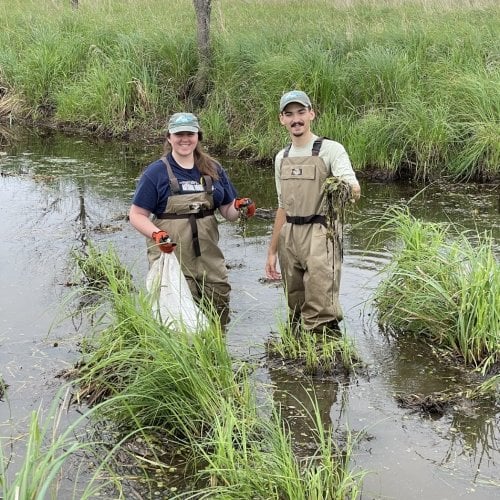 KISMA crew at European Frog-bit identification and management training.
KISMA crew at European Frog-bit identification and management training.
Photo credit: Sigrid Resh
European Frog-bit Early Detection Rapid Response (EDRR) Project
Funded by a partnership with the National Park Service, part of a UP-wide collaboration with the Upper Peninsula Resource Conservation and Development Council with funding provided by the Michigan Invasive Species Grant Program
What we did
- Surveyed lake, stream, and river shoreline for European frog-bit and other Aquatic invasive species in similar habitats.
- Educated the public about European frog-bit and how to prevent it.
To learn more about European frog-bit, visit KISMA's European frog-bit webpage.
Accomplishments
- Nearly 100 linear miles of Keweenaw waterways surveyed.
- Hosted 2 AIS Landing Blitz events- a regional project promoting Clean, Drain, Dry messaging.
- Contacted nearly 200 people at KISMA/NPS boatwash events in addition to boat inspections and cleaning.
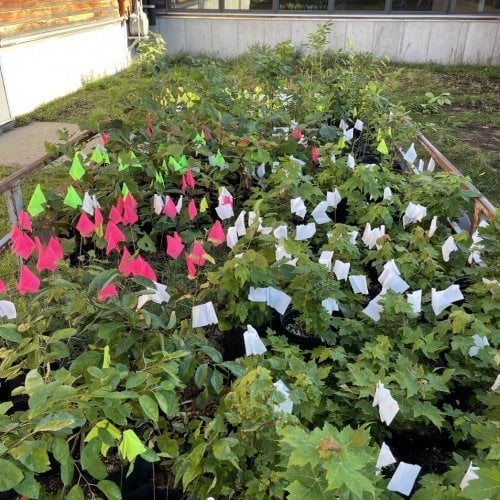 Trees with flagging prior to planting.
Trees with flagging prior to planting.
Photo credit: Sigrid Resh
Emerald Ash Borer Mitigation and Forest Restoration Project
Funded by USDA Forest Service, Great Lakes Restoration Initiative
What we did
- Removed forest invasive woody plant species and replaced them with native shrubs and trees along ski trails and forest overstory loss from the invasive Emerald Ash Borer.
- Planted more than 1600 native trees and shrubs such as sugar and red maples, red and bur oaks, yellow birch, hemlock, northern white cedar, highbush cranberry, new jersey tea, red osier dogwood, willows etc.
Accomplishments
- 1600+ native trees and shrubs planted on the Michigan Tech Trails.
- Engaged and educated students and community volunteers on invasive species and forest restoration.